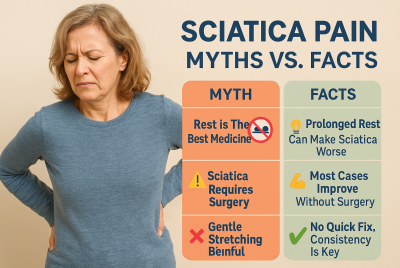Pilates for Sciatica
Discover how Pilates for sciatica can alleviate pain and improve mobility. Learn key exercises and tips for relief. Start your journey to wellness today! As someone passionate about sciatica health and eager to provide helpful suggestions, I understand the frustration and limitations it can impose on daily life. Sciatica, characterized by pain radiating along the sciatic nerve, can be debilitating and challenging to manage. However, through my journey, I’ve discovered the incredible benefits of Pilates in alleviating sciatica symptoms and improving overall well-being.
Understanding Sciatica
Before delving into how Pilates can help, it’s essential to grasp the basics of sciatica. Sciatica refers to pain that radiates along the path of the sciatic nerve, which branches from your lower back through your hips and buttocks and down each leg. It typically affects one side of your body and can vary from a mild ache to excruciating pain.
Several factors can contribute to sciatica, including herniated discs, spinal stenosis, muscle imbalances, and poor posture. Common symptoms include shooting pain, tingling, numbness, or weakness in the lower back, buttocks, and legs.
How Pilates Can Help
Pilates offers a multifaceted approach to alleviating sciatica symptoms by targeting core strength, flexibility, and postural alignment. Strengthening core muscles, including abdominals and back muscles, provides better support to the spine, reducing pressure on the sciatic nerve. Gentle stretching exercises in Pilates enhance flexibility and alleviate stiffness around the spine and hips, easing discomfort. Moreover, Pilates emphasizes proper alignment and body awareness, mitigating strain on the lower back caused by poor posture. By practicing Pilates regularly, individuals with sciatica can experience improved pain management, increased mobility, and enhanced overall well-being.
Benefits of Pilates for Sciatica
Improved Core Strength: Strengthening the core muscles, including the abdominals, back muscles, and pelvic floor, can provide better support to the spine and alleviate pressure on the sciatic nerve.
Enhanced Flexibility: Pilates emphasizes gentle stretching exercises that target the muscles surrounding the spine and hips, promoting flexibility and reducing stiffness, which can exacerbate sciatica symptoms.
Postural Alignment: Poor posture is a common contributing factor to sciatica. Pilates exercises focus on proper alignment and body awareness, helping individuals maintain a neutral spine and alleviate strain on the lower back.
How to Stop Sciatica Pain with Pilates
Key Pilates Exercises for Sciatica Relief
Key Pilates exercises for sciatica relief include Cat-Cow Stretch, Child’s Pose, Spinal Twist, Pilates Hundred, Leg Circles, Bridging, Pelvic Clocks, Single Leg Stretch, and Swan Dive Prep. These exercises promote flexibility, strength, and spinal mobility.
Gentle Stretches for the Lower Back:
Cat-Cow Stretch
The Cat-Cow Stretch is a gentle Pilates exercise that targets the spine and promotes flexibility. Begin on your hands and knees, arching your back upwards like a cat while exhaling, then lower your spine and lift your head upwards while inhaling. This movement helps relieve tension in the spine and may alleviate discomfort associated with sciatica.
Child’s Pose
Child’s Pose is a restorative Pilates stretch that provides relief for the lower back and hips. Begin on your hands and knees, then lower your hips back towards your heels while reaching your arms forward and resting your forehead on the ground. This posture gently stretches the spine and may help alleviate sciatica discomfort.
Spinal Twist
The Spinal Twist is a Pilates exercise that targets the muscles surrounding the spine, promoting flexibility and relieving tension. Lie on your back with arms extended out to the sides, then gently rotate your legs to one side while keeping your shoulders grounded. This movement helps alleviate stiffness in the spine and may ease sciatica discomfort.
Strengthening Exercises for Core Muscles:
Pilates Hundred
The Pilates Hundred is a core-strengthening exercise that improves abdominal strength and endurance. Lie on your back with your legs raised and arms pumping up and down while breathing rhythmically for a count of one hundred. This dynamic movement engages the core muscles deeply, promoting stability in the spine and potentially reducing sciatica symptoms over time.
Leg Circles
Leg Circles is a Pilates exercise that targets the core and hip muscles, improving stability and flexibility. Lie on your back with one leg extended upward and the other resting on the ground, then rotate the raised leg in circular motions. This movement strengthens the hip muscles and may help alleviate sciatica discomfort.
Bridging
Bridging is a Pilates exercise that strengthens the glutes, hamstrings, and core muscles while promoting spinal mobility. Lie on your back with your knees bent, then lift your hips off the ground while engaging your core and squeezing your glutes. This movement stabilizes the spine and may alleviate tension associated with sciatica.
Pelvic Stabilization Exercises:
Pelvic Clocks
This Pilates exercise is designed to improve pelvic mobility and stability. Lie on your back with your knees bent, then visualize your pelvis as a clock face. Rotate your pelvis in a clockwise and counterclockwise motion, focusing on controlled movements. This exercise helps alleviate lower back and hips stiffness, potentially reducing sciatica discomfort.
Single Leg Stretch
The Single Leg Stretch is a dynamic Pilates exercise that targets the core muscles and improves hip flexibility. Lie on your back with your knees bent, then hug one knee towards your chest while extending the other leg straight out. Alternate legs in a rhythmic motion, engaging the core to stabilize the spine and potentially relieve sciatica discomfort.
Swan Dive Prep
Swan Dive Prep is a Pilates exercise that strengthens the back muscles while promoting spinal extension and flexibility. Lie on your stomach with arms extended in front of you, then lift your chest and arms off the ground while keeping the gaze forward. This movement helps alleviate tension in the spine and may ease sciatica discomfort over time.
Tips for Practicing Pilates Safely with Sciatica
While Pilates can be incredibly beneficial for individuals with sciatica, it’s essential to approach it with caution and mindfulness.
Importance of Proper Form
Maintaining proper form is crucial to prevent exacerbating sciatica symptoms. Focus on alignment and engage your core muscles throughout each exercise to protect your spine and minimize strain.
Modifications for Individuals with Sciatica
Listen to your body and modify exercises as needed to avoid aggravating your symptoms. For example, if a particular movement causes pain or discomfort, consider adjusting the range of motion or using props for support.
Listening to Your Body
Pay attention to how your body responds to each exercise and adjust accordingly. It’s essential to distinguish between discomfort from muscle fatigue and pain from underlying sciatica issues. If you experience sharp or shooting pain, stop the exercise immediately and consult with a healthcare professional.
Incorporating Pilates into Your Routine
To integrate Pilates into your routine effectively, start with 2-3 weekly sessions and gradually increase frequency as you gain strength and flexibility. Consistency is key for optimal results. Additionally, consider complementing Pilates with other forms of exercise, such as walking or yoga, to promote overall health and well-being. Listen to your body, and if you experience discomfort, adjust your routine accordingly. Consulting with a certified Pilates instructor can provide personalized guidance and ensure safe and effective practice.
Consulting a Professional
Before embarking on a Pilates program, it’s essential to consult with a healthcare provider, especially if you have underlying medical conditions like sciatica. Additionally, seek guidance from a certified Pilates instructor who can tailor exercises to suit your individual needs and ensure proper technique and safety.
Real-Life Success Stories
Countless individuals have found relief from sciatica through Pilates. The benefits are undeniable, from reducing pain and improving mobility to enhancing overall quality of life. Here are a few testimonials from individuals who have experienced the transformative power of Pilates:
Lisa, NC: “After years of struggling with sciatica, Pilates has been a game-changer for me. Not only has it alleviated my pain, but it has also improved my posture and overall strength.”
Robby, OH: “I was skeptical at first, but after just a few weeks of consistent Pilates practice, I noticed a significant reduction in my sciatica symptoms. I feel more empowered and in control of my body.”
FAQs Related to Pilates for Sciatica
Is Pilates suitable for everyone with sciatica?
While Pilates can be beneficial for many individuals with sciatica, it’s essential to consult with a healthcare professional before starting any new exercise program, especially if you have underlying medical conditions.
How soon can I expect to see results from practicing Pilates for sciatica?
Results may vary depending on the severity of your condition and how consistently you practice Pilates. Some individuals may experience relief from symptoms within a few weeks, while others may take longer. Patience and consistency are key.
Can I do Pilates if I have acute sciatica flare-ups?
Listening to your body and avoiding exacerbating symptoms during acute flare-ups is essential. Consider modifying exercises or taking a break until the pain subsides. Always prioritize your safety and well-being.
Are there any specific Pilates exercises I should avoid with sciatica?
While many Pilates exercises can be beneficial for individuals with sciatica, some may exacerbate symptoms if performed incorrectly or without proper guidance. Consult with a certified Pilates instructor for personalized recommendations.
Can Pilates alone cure sciatica?
While Pilates can help alleviate symptoms and improve overall spinal health, it’s essential to approach sciatica management holistically. A combination of Pilates, proper nutrition, stress management, and other therapeutic modalities may be necessary for long-term relief.
Pilates for Sciatica – Conclusion
In conclusion, Pilates offers a safe, effective, and holistic approach to managing sciatica. By incorporating Pilates exercises into your routine and prioritizing proper form and technique, you can experience relief from pain, improve flexibility, and enhance overall well-being. Remember to consult with a healthcare professional and seek guidance from a certified Pilates instructor to ensure a safe and effective practice.
Disclaimer
Please note that the information provided in this article is for informational purposes only and should not replace professional medical advice. If you’re experiencing sciatica pain or any health concerns, it’s advisable to consult a healthcare professional for proper diagnosis and treatment.






